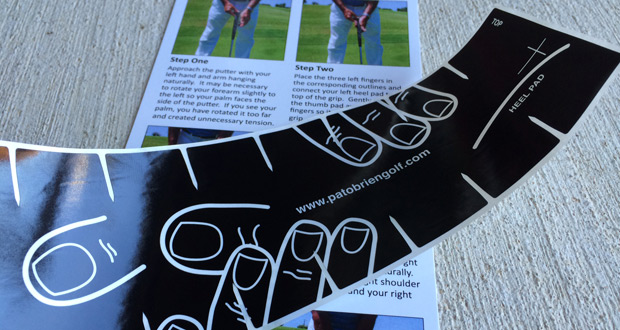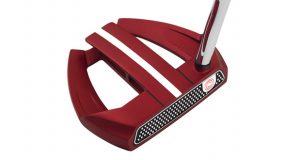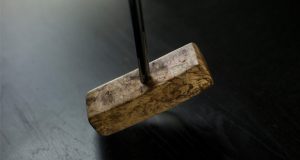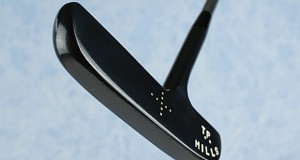Pat O’Brien almost needs no introduction on PutterZone, as we have been a fan of his here since the launch of the site seven years ago. Pat is a noted putting instructor to major champions such as Zach Johnson and many others. He is a longtime ambassador for SeeMore putters. He is a teaching professional at Lakewood Country Club in Dallas. He was a close friend of the late, great Payne Stewart. He was also kind enough to serve as a technical adviser to our putting fitting book, Putter Perfection.
As if that’s not enough, Pat has now launched a new product designed to help you get a better grip on your putter. The Perfect Putting Grip ($19.99) is a label that you place onto your putter grip, showing you exactly where to place your fingers to achieve what Pat calls the “modern putting grip.” The label fits any size of grip. It is durable, yet easily removable once you feel you’ve mastered the grip. You also get a second label for when you need a refresher, as well as reference card showing you how to apply and use the label. An included QR code provides access to reference videos. Following is our exclusive interview with Pat O’Brien about the Perfect Putting Grip:
You are a proponent of what you call the “modern putting grip.” How does the modern grip differ from the traditional grip, and what makes it better?
The modern grip is based in the fingers, with the left or lead hand heel pad on top of the grip for leverage as it is in a regular golf swing. The traditional grip is based in the palm or “lifeline,” where the thumb pad is recruited for leverage.
Back in the day, so to speak, greens were grainy, slow and bumpy. They were common Bermuda grass. The style was to employ a wristy or pop stroke to get the ball rolling. In 1981, Augusta National switched to bent grass and that ushered in an agronomical revolution. Greens could now be faster and smoother. There are now several hybrid strains of Bermuda that achieve the same effect as bent but are more heat tolerant. So the style of putting has changed. Most good putters now are swingers and not hitters.
The easiest way to be a swinger is to free up your wrist joints, so the weight of the putter head can swing up on the way back and naturally fall down on the way through. A putter is essentially a weight on a stick, so this is how it is designed to swing. Since your heel pad has the leverage, the thumb pad can stay relaxed. The thumb pad is connected to the wrist joint, so it remains free. This is a biomechanically correct grip.
You can fold your fingers in half and press as hard as you want, with no tension radiating into your forearms or shoulders. So you can grip a golf club or a putter as securely as you want in the fingers. It is only when you recruit the palms or thumbs that tension develops and the club becomes heavy. Most people try to remove that tension through oversized putting grips or going to the claw or saw. If you establish proper leverage with your lead hand in the beginning, this won’t be necessary. You would never be an effective golfer if you gripped the club in the palm or lifeline of your lead hand. I don’t believe it should be any different with the putter.
You have taught your grip to thousands of golfers, now you have created a new product that allows anyone to learn the grip on their own. What is the Perfect Putting Grip, and how does it work?
The Perfect Putting Grip is a sticker or label that attaches to your current grip. It has outlines of where all your fingers and your heel pad should go. It comes with an instructional card and pictures to help you learn a finger based grip. It also has a QR code or link to some short putting videos I have created to help you with all your fundamentals. It is really very simple to use.
How did you come up with the idea of the Perfect Putting Grip, and what was your experience going from concept to finished product?
A long time student of mine, Steve Illions, thought that my grip made so much sense. He asked me if I ever thought about creating a training aid for it and to be honest, I had not. So we became partners and went on a quest to develop one.
We started with a clay mold of my hands pressed into a grip. We then turned that into a very cool 3D mold made of hard plastic. Those molds were cost prohibitive to market, but we intended to turn it into a rubber grip like you see for full swing grip training aids. However, this too was going to be expensive and we thought ultimately impractical. I wanted something that people could use without cutting off their existing grip.
After some research, Steve found a label making company here in Dallas. They were incredibly helpful and the product turned out better than we had hoped. You can leave it on your grip as long as you want. Should you need a refresher down the line, we include an extra label in the packet. We can also easily customize the labels for corporate outings or change colors for different marketing opportunities.
For some golfers, the switch from a traditional palm-based grip to more of a finger-based grip can be alien or uncomfortable at first—what is your advice to them?
I can certainly appreciate that. First of all, the motivation has to be there. This truly is a more effective way to putt as your hands work together and you are allowing the feel to be in your fingertips. Your lead hand will not break down because of the leverage you have established.
When most people learn a new grip, the inclination is to become tense! They rotate their left hand counterclockwise and right hand clockwise so they can see their palms and micromanage the process. My advice is to relax and let your arms hang freely. I would even practice without looking at your hands after a little while. The beauty of this training aid is that there is no guesswork. With all the resources we include, you will be able to change your grip! Stay relaxed, it helps you learn faster.
After a golfer gets in a groove with the Perfect Putting Grip, do you have any other fundamental putting advice pertaining to setup, stroke or style of putter?
The most efficient way to putt is to allow your hands, arms, chest and shoulders to move the way they are designed. Allow the putter to swing the way it is designed. I call it physics and biomechanics for dummies, of whom I am one. When your fundamentals are correct, these things can happen pretty easily. The QR code includes 7 short videos, from putter fittings to fundamentals to pre putt routine. My goal is to have someone completely engaged in the picture of the putt, with no anxiety about mechanics or results. Since the grip is your connection to the club, I feel like a big step has been made to help golfers achieve this goal.
Thanks, Pat! Stay tuned for our Perfect Putting Grip review.
 PutterZone – Best Putter Reviews
PutterZone – Best Putter Reviews




